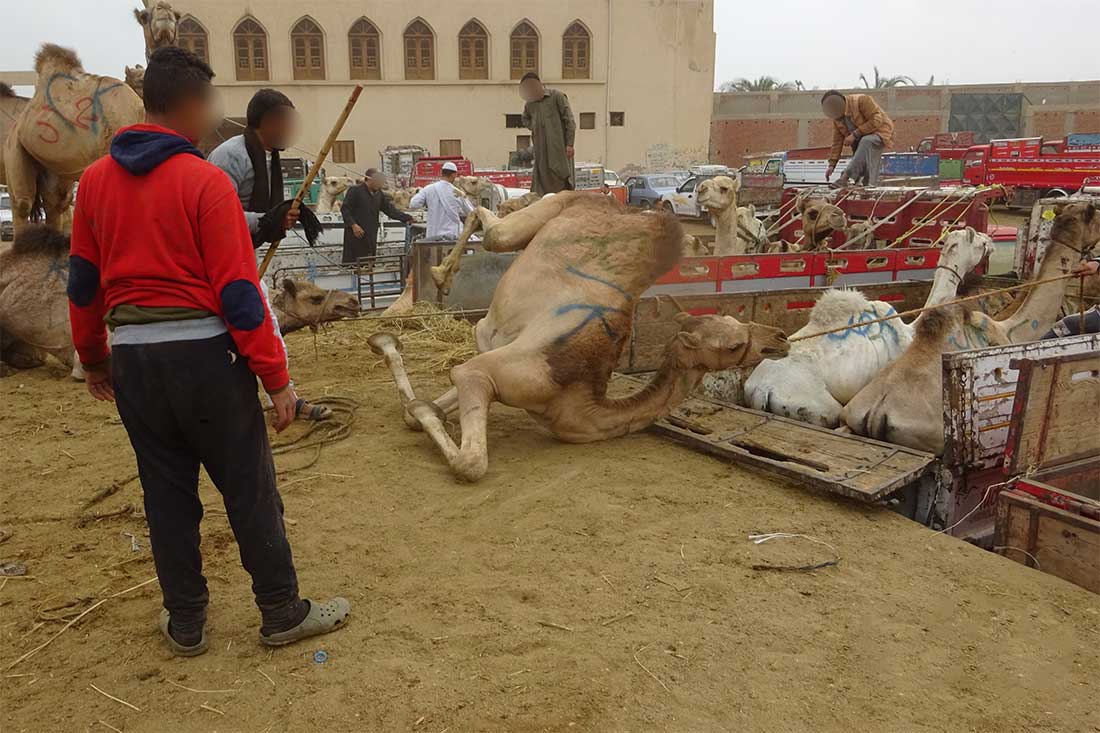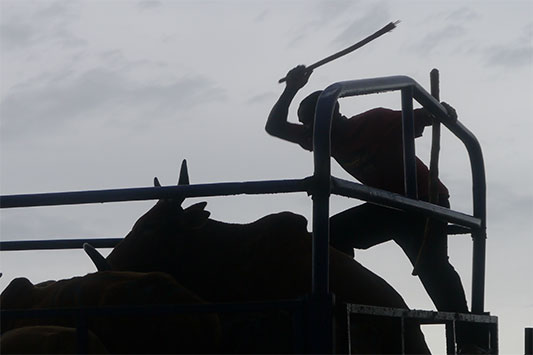Camel Transport
Like all 'farm' animals, camels are also transported. Often over short distances to an animal market or to the nearest slaughterhouse. Sometimes, however, they are transported over long distances for days and weeks – by land and by sea. This applies to 'racing' camels as well as to 'breeding' and 'slaughter' camels. As with all 'farm' animals, the quality of transport often depends on the economic value given to the animals.
What are the Animals Suffering From?
No special vehicles: There are hardly any vehicles designed for the transport of camels. Multifunctional vehicles and pick-ups are generally used.
Restraining with shackles: For safety reasons, camels should lie down during road transport. Standing is not even an option in standard transport vehicles, as they have no or unstable side walls. Thus, the camels' legs are tied together for transport (often for days) so that they cannot stand up.
Incising leg shackles: Instead of soft materials, very often thin, incising materials are used. For example, hay strings or even thin wire in the worst cases.
No bedding: The better transports are lined with carpets or even mattresses to protect the animals during transport. Sometimes sand is also used. But in many and also very long transports, no bedding material is used at all. The camels then have to sit for days on the bare and hard metal floor. This leads to pain, abrasions and hematomas.
No weather protection.
No loading ramps.
No trained personnel.
What Animals' Angels Does Against it
In an intensive field study, we were on site in various countries in the Middle East, documenting and accompanying camel transports. In order to draw attention to the glaring abuses, we addressed the responsible authorities, governments as well as veterinarians and other experts in this field, universities and research institutes as well as other stakeholders in the region with a comprehensive report. Our report is accompanied by a short film about the problems we documented. We presented our report and video at a high-level camel conference in Laayoune and were able to get an international hearing for the camels.
We continue to be in close contact with experts, authorities and other stakeholders in the region and urge those responsible to take action. Animal welfare in the transport of camels is still uncharted territory - so far there are almost no legal regulations and hardly any awareness of this issue.
Our Goals:
- Animal welfare must be addressed during transport of camels – on-site as well as at international conferences, expert meetings and workshops.
- The introduction, implementation and enforcement of animal protection laws in the respective countries, which also protect the animals during transport.
- Compliance with the internationally agreed animal welfare standards of the OIE (World Animal Health Organisation).
- On-site education and training for traders, workers and camel owners.
- More awareness and empathy for camels.
![[Translate to englisch:] Julia Havenstein [Translate to englisch:] Julia Havenstein](https://www.animals-angels.de/fileadmin/user_upload/01_Ueber_uns/Menschen/JH.jpg)
![[Translate to englisch:] Helena Bauer [Translate to englisch:] Helena Bauer](https://www.animals-angels.de/fileadmin/user_upload/01_Ueber_uns/Menschen/HB.jpg)
![[Translate to englisch:] Ali Ziani [Translate to englisch:] Ali Ziani](https://www.animals-angels.de/fileadmin/user_upload/01_Ueber_uns/Menschen/ALI.jpg)
Project Management:
Julia Havenstein
Helena Bauer
Projekt Assistant:
Ali Ziani













![[Translate to englisch:] Conference of the Camels, Saudi Arabien 2024 [Translate to englisch:] Conference of the Camels, Saudi Arabien 2024](https://www.animals-angels.de/fileadmin/user_upload/06_Neuigkeiten/2024/2024_03_06_Saudi_Arabia_Camel_Conference.jpg)








